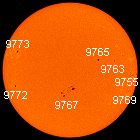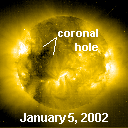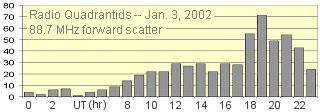|   SPACE WEATHER SPACE WEATHER
Current
Conditions
Solar Wind
velocity: 279.9 km/s
density:1.4 protons/cm3
explanation | more data
Updated: Today at 2245 UT
X-ray Solar Flares
6-hr max: M1 1835 UT Jan05
24-hr: M1 1835 UT Jan05
explanation | more data
Updated: Today at 2245 UT
Daily Sun: 05 Jan '02 
Active region 9767 has a beta-gamma magnetic fields that poses a threat for M-class solar flares. 9767 unleashed an impressive X3-class flare on Dec. 28th. Image credit: SOHO/MDI
The Far Side of the Sun

This holographic image reveals a large sunspot group on the far side of the Sun. Image credit: SOHO/MDI
Sunspot Number: 248
More about sunspots
Updated: 04 Jan 2002
Radio Meteor Rate
24 hr max: 12 per hr
Listen to the Meteor Radar!
Updated: 05 Jan 2002 Interplanetary Mag. Field
Btotal: 5.9 nT
Bz: 4.8 nT north
explanation | more data
Updated: Today at 2246 UT Coronal Holes:

A substantial coronal hole is rotating toward the Sun's central meridian. Image credit: SOHO Extreme UV Telescope.
More about coronal holes
 SPACE WEATHER SPACE WEATHER
NOAA
Forecasts
Solar Flares: Probabilities for a medium-sized (M-class) or a major (X-class) solar flare during the next 24/48 hours are tabulated below.
Updated at 2002 Jan 04 2200 UT
| FLARE | 0-24 hr | 24-48 hr | | CLASS M | 60 % | 60 % | | CLASS X | 15 % | 10 % |
Geomagnetic Storms: Probabilities for significant disturbances in Earth's magnetic field are given for three activity levels: active, minor storm, severe storm
Updated at 2002 Jan 04 2200 UT Mid-latitudes | 0-24 hr | 24-48 hr | | ACTIVE | 15 % | 30 % | | MINOR | 05 % | 10 % | | SEVERE | 01 % | 05 % |
High latitudes | 0-24 hr | 24-48 hr | | ACTIVE | 20 % | 35 % | | MINOR | 10 % | 15 % | | SEVERE | 01 % | 05 % |

Web server provided by
VPS Hosting | What's Up in Space -- 5 Jan 2002
Subscribe to Space Weather News! SOLAR BLAST: A solar filament erupted near active region 9773 on Jan. 4th and hurled an unusually beautiful coronal mass ejection (CME) into space. "The complexity and structure of the CME amazed even experienced solar physicists at the SOHO operations center," says Paal Brekke, the SOHO Deputy Project Scientist. The eruption was not substantially Earth-directed. Nevertheless, the outskirts of the expanding cloud could sweep past our planet on Jan. 6th or 7th and trigger geomagnetic activity.  Above: (left) An ultraviolet-wavelength image of the erupting filament; (middle and right) SOHO coronagraph pictures of the expanding CME. Click on the image for movies of the eruption.  NEAR-EARTH ASTEROID: A newly-discovered near-Earth asteroid named 2001 YB5 will race past our planet this weekend only two times farther away than the Moon. During the days leading up to its closest approach on Jan. 7th, the 300 meter-wide space rock will brighten to 12th magnitude -- an easy target for backyard telescopes equipped with CCD cameras. [3D orbit] [ephemeris] NEAR-EARTH ASTEROID: A newly-discovered near-Earth asteroid named 2001 YB5 will race past our planet this weekend only two times farther away than the Moon. During the days leading up to its closest approach on Jan. 7th, the 300 meter-wide space rock will brighten to 12th magnitude -- an easy target for backyard telescopes equipped with CCD cameras. [3D orbit] [ephemeris]
Above: On Jan. 4th, John Rogers recorded this movie of fast-moving 2001 YB5 while it was 0.052 AU from Earth. [more]
QUADRANTID METEORS: The annual Quadrantid meteor shower peaked on Thursday, January 3rd. As expected, most visual observers saw, at best, a modest display (10 or so per hour); the Quadrantids were overwhelmed this year by a glaring nearly-full Moon. Radio meteor listeners, however, recorded plenty of "pings" -- signals from radio stations reflected by ionized meteor trails -- during the shower's brief maximum around 1800 UT. It was a good year to listen to the Quadrantids! 
Above: Engineer Stan Nelson of Roswell, NM, recorded more than 70 radio echoes per hour during the Quadrantid maximum. SUBTLE ECLIPSE: "Unless you knew it was happening you wouldn't even notice," says sky watcher Stan Richard. Photographer Phil Harrington agreed: "The Moon's teaming with Jupiter was far more visually interesting than the eclipse." Such was the recent lunar eclipse, which happened on Dec. 30th when the Moon glided through the outskirts of Earth's shadow. Visit our photo gallery and see for yourself! WEB LINKS: NOAA FORECAST | GLOSSARY | SPACE WEATHER TUTORIAL | LESSON PLANS | BECOME A SUBSCRIBER | 
Potentially Hazardous Asteroids (PHAs) are space rocks larger than approximately 100m that can come closer to Earth than 0.05 AU. None of the known PHAs are on a collision course with our planet, although astronomers are finding new ones all the time.
On 5 Jan 2002 there were 361 known Potentially
Hazardous Asteroids Jan. 2002 Earth-asteroid encountersNotes: LD is a "Lunar Distance." 1 LD = 384,401 km, the distance between Earth and the Moon. 1 LD also equals 0.00256 AU. MAG is the visual magnitude of the asteroid on the date of closest approach. 
- MOON & SATURN: The Moon keeps getting in the way of Saturn! See the series of close encounters here.
- CHRISTMAS LIGHTS: On Christmas Eve, 2001, a solar wind stream triggered Northern Lights. [gallery]
- SOLAR ECLIPSE: Sky watchers in Hawaii and most parts of North America experienced a partial solar eclipse on Dec. 14th. [gallery]
- BRIGHT ASTEROID: Videos and images of 1998 WT24 -- a big and bright near-Earth asteroid that came close to our planet on Dec. 16, 2001. [gallery]
- NORTHERN LIGHTS: On Nov. 24th a pair of coronal mass ejections swept past Earth and triggered worldwide auroras.
- LEONIDS 2001: Some people saw it. Others heard it. In either case, they'll never forget it: The 2001 Leonid meteor storm.
- PERSEIDS 2001: Perseid watchers on August 12th spotted meteors, auroras, and a disintegrating Russian rocket! [gallery]
- MORNING PLANETS: In July and Aug. 2001, the Moon, Jupiter, Saturn, Venus, and Mercury put on a dazzling early-morning sky show. [gallery]
- ECLIPSE SAFARI: Onlookers cried out in delight on June 21, 2001, when the Moon covered the African Sun, revealing the dazzling corona. [gallery]
- TOTAL LUNAR ECLIPSE: On Jan. 9, 2001, the full Moon glided through Earth's copper-colored shadow. [gallery]
- CHRISTMAS ECLIPSE: Sky watchers across North America enjoyed a partial solar eclipse on Christmas Day 2000 [gallery]
- LEONIDS 2000: Observers around the globe enjoyed three predicted episodes of shooting stars. [gallery]
 Nov. 7 , 2001: What Lies beneath a Sunspot -- Awesome plasma hurricanes were one of the surprises revealed when scientists peered beneath the stormy surface of our star. Oct. 26 , 2001: 'tis the Season for Auroras -- Autumn is a good time to spot Northern Lights. Oct. 17, 2001: Halley's Comet Returns ... in bits and pieces -- The annual Orionid meteor shower peaks on October 21st. Aug. 9, 2001: Horse Flies and Meteors -- Like bugs streaking down the side window of a moving car, long and colorful Perseid Earthgrazers could put on a remarkable show on August 11th. July 27, 2001: Meteorites Don't Pop Corn -- A fireball that dazzled Americans on July 23rd probably didn't scorch any cornfields, contrary to widespread reports. June 12, 2001: The Biggest Explosions in the Solar System -- NASA's HESSI spacecraft aims to unravel an explosive mystery: the origin of solar flares. |

